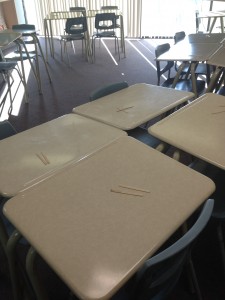Well I’ve gone and done it. I’ve tried the first of three co-operative structures to encourage discussion in my FSL classroom. I’ve selected these from Kagan Cooperative Learning by Dr. Spencer Kagan and Miguel Kagan. Thank you to @Think_teach for pointing me in this direction!
This strategy is called “Talking chips”. I’ve referred to it as a talking stick, version 2.0, since everyone gets 2 sticks to start. Here is a brief explanation of my use of this strategy:
- Students receive a maximum of 2 ‘chips’ each.
- When a student talks, they put a chip in the centre of their group of desks.
- Students can only talk if they have a chip.
- No chips left? Wait until everyone has placed their chips in the centre and start again.
In my Gr. 12 class, I presented brief videos about current events, and then provided the discussion questions. I used Popsicle sticks since I didn’t want coins/tokens to turn into a game of penny football. Besides, I already had them on hand.
Here is a picture of my classroom set up. Luckily the teacher I share the classroom with is very open to this arrangement. Kagan suggests that “[t]eams of four are ideal. They allow pair work, which doubles active participation, and open twice as many lines of communication compared to teams of three”.
Student feedback was positive (1-2 thumbs up from everyone!), as they all had the chance to speak and felt that there was accountability. One student commented that he didn’t know how much time they had to speak, so I’ve since posted an online counter to help with this: http://www.online-stopwatch.com/countdown-timer/. Also, some groups ended early; I had forgotten to mention they could each take 2 sticks back and continue speaking.
Questions for reflection. Or hey, if you have any solutions, let me know…
- If a student says a short phrase such as “I agree”, is this worth a chip?
- What about side conversations that end up occurring between two students who are already chipless, but are having a good on-task discussion?
- How can I most efficiently set-up this structure? Maybe putting a piece of coloured paper to mark the centre where they can place their chips to let me quickly gauge how many times students have spoken? Maybe have students pick up their chips as they enter the class so that they’re just ready to go with the discussion questions instead of waiting for my lead?
Have you used this structure before?
Next up: RoundRobin & RallyRobin and Simultaneous RoundTable. Not necessarily in that order. And not necessarily in my next post…

Amazing post, Vivienne. I really enjoyed reading it!
Would you be able to post where you found this resource (that is, if it is online)?
I have done something similar, but the popsicle sticks are coloured. Each colour represents a different way to contribute to the discussion. I think this is how I organize it:
Green: New thought
Blue: Add on
Red: Probing / Challenge Question
Blue: Clarifying question
Yellow: Connection
I find with my grade 7 students, having a gentle scaffold like this allows them to know what kind of contributions produce fruitful discussions and what kind of contributions are not effective (the “I agree” responses).
Please keep sharing these ideas and reflections…they are so valuable to share and learn from!
I’ve heard that Harkness has a conversation tracking format for Learning Conversations, that not only helps show how many contributions each student makes, but also shows the direction of the conversation – noting who picks up on the thoughts of whom, and whether they do build, challenge, redirect etc.
It sounds like your chips method will run itself, but if you’re interested in providing some conversation data for class reflection, you might take a look at this example.
http://www.edutopia.org/pdfs/stw/edutopia-stw-collegeprepHS-collaboration-harkness-good.pdf
Merci, Adam. Very timely as I’m planning on doing Harkness tables in the next few weeks. I had heard about them and observed one in a colleague’s English classroom. When I first presented the idea to my students they were taken aback that I’d expect them to do it in French. Afterwards, though, they were more confident in their abilities to think on their feet and communicate their ideas in French. I love the spider-web effect of the diagram from the link you provided. I’ve used it before and you’re right – it’s a great visual for a conversation/reflection piece with students.